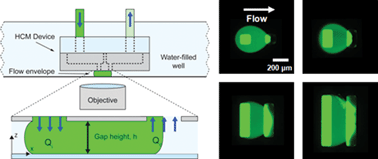Closed-channel microfluidic devices are widely used in a number of chemical and biological applications; however, it is often difficult to interact with samples, such as cells, that are enclosed inside them. Hydrodynamically confined microflows (HCMs) allow microfluidic-type flows to be generated in open liquid environments, such as Petri dishes, thus greatly increasing the flexibility of microfluidic approaches. HCMs have previously been used for protein patterning and selective cell treatment applications, but the underlying fluid mechanics is not fully understood. Here, we examine the effect of device geometry and flow parameters on the properties of the flow envelope and pressure drop of several two-port HCM devices using a combination of experiments and modeling. A three-port device, which allows for different flow envelope shapes to be generated, is also analyzed. The experimental results agree well with the 3-D computational fluid dynamics simulations, with the majority of the measurements within 10% of the simulations. The results presented provide a framework for understanding the fluid mechanics of HCMs and will aid in the design of HCM devices for a broad range of applications.

You have access to this article
 Please wait while we load your content...
Something went wrong. Try again?
Please wait while we load your content...
Something went wrong. Try again?


 Please wait while we load your content...
Please wait while we load your content...